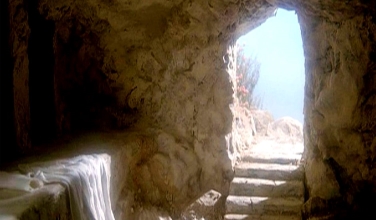
Lie: Jesus’ resurrection means we will live forever in heaven.
Truth: Jesus’ resurrection means we can fearlessly and sacrificially love like Christ and signals that the new creation has begun.
God is always painting on a much bigger canvas than we can imagine and resurrection is his master stroke. But Christians normally interpret this, the watershed of all history, too narrowly. Consequently, what we’re often left with is a diluted, pie-in-the-sky sentimentality. We typically store away resurrection only to be dusted off briefly during the Easter season.
We know that the death and resurrection of Jesus is central to history and to our own Christian lives, but our limited grasp of it often dilutes the impact that it should have. We need to go deeper to really understand what God did when He raised Jesus from the dead.
One way to take a fresh look at resurrection is to see what it meant to the Jews in Jesus’ day. When Jesus walked the earth, belief in the resurrection meant more than just the raising of the dead. It had a much larger context. To first-century Jews who believed in resurrection (remember the Sadducees who didn’t believe in it?), it was a belief in God’s plan to completely restore all of creation. First-century Jews did not believe in a coming suspension of space and time, in other words they did not believe that God would create a different world out of whole cloth. The afterlife wasn’t going to shuffle us away to some dimension where we would float around on clouds, playing harps. No.
God was going to restore this world – the home that we’ve grown up in and where God put us in the first place. God was going to re-create the human family, and he was going to do it by resurrection. It was a faith that God could literally raise the dead if he had to, and . . . it turns out that He actually did have to.

The belief in resurrection trusted in the God who can do the impossible and who will go to any length to restore and redeem His creation. It was a hope that, despite all appearances, despite the overwhelming odds, and despite the fact that thousands had died while living under covenant and in the hope of the kingdom and yet had never received the promises of that Kingdom, God would completely vindicate and restore everything ANYWAY by raising them from the dead.
They believed in the ultimate victory of God, that the sovereign Lord ultimately would have His way, and nothing – not even disease, destruction and death – would defeat Him.
So when this corruptible has put on incorruption, and this mortal has put on immortality, then shall be brought to pass the saying that is written: ‘Death is swallowed up in victory.’ ‘O Death, where is your sting? O Hades, where is your victory?’ – I Corinthians 15:54–55
We cannot continue to be confused about such a major doctrine. For the sake of our loved ones and the integrity of the gospel message to the world, we need to sort out why the resurrection is so important and how to communicate it to the world by our words and our actions.
From his book, Surprised by Hope, Rethinking the Resurrection, Heaven, and the Mission of the Church, theologian N. T. Wright gets us on the right path:
And the question of Jesus’s resurrection, although it may in some senses burst the boundaries of history [that is, it’s unprecedented], also remains within them; that is precisely why it is so important, so disturbing, so life-and-death. We could cope — the world could cope — with a Jesus who ultimately remains a wonderful idea inside the disciples’ minds and hearts. The world cannot cope with a Jesus who comes out of the tomb, who inaugurates God’s new creation right in the middle of the old one.[1]
Just so, our faith must break out of our own private, internal world. Of course, it affects us there if we’re truly born from above, but it cannot stay there. Just as Jesus physically came out of the tomb – his body was ‘used up’ and was no longer there in the tomb – so we must also use our everyday, normal life: how we use our mouth, eyes, hands, and feet.
We must let this sink in deeply. The kingdom starts here and now and will continue until God renovates the heavens and the earth by divine fire and Jesus, the Lion/Lamb ushers in the visible kingdom. Until then we demonstrate the reality of this new life by allowing his resurrection life to flow through us.
In his second letter to the Corinthians, Paul reveals his own struggles more than in any other letter.
God . . . through us diffuses the fragrance of His knowledge in every place. (2 Corinthians 2:14)
You are our letter written in our hearts, known and read by all men. (3:2)
We all, with unveiled face, beholding as in a mirror the glory of the Lord, are being transformed into the same image . . . (3:18)
For we do not preach ourselves, but Christ Jesus the Lord, and ourselves your bondservants for Jesus’ sake. (4:5)
But we have this treasure in earthen vessels, that the excellence of the power may be of God and not of us. (4:7)
For we who live are always delivered to death for Jesus’ sake, that the life of Jesus also may be manifested in our mortal flesh. (4:11)
I could go on, but what’s the message here? It is not that we will one day escape to live forever in heaven (or on earth for that matter) – that old, tired belief only demeans the message and our God. God has chosen to speak His powerful Word though weak and broken vessels like you and me. That is the message. The small words we speak only reinforce the bigger message, the more adequate God. It’s the retelling of the cross and resurrection of Jesus in a thousand, different ways. It’s told when, despite our hardships, small and large, we, without fear of death or suffering, continue to do what we need to do: to love, to care, to believe, to talk, to listen, to forgive for the thousandth time. People should be constantly hearing this ‘music of resurrection’ through us. Do they?
See also the Introduction, Lies attacking our relationship to God.
[1] Wright, N T, Surprised by Hope, Rethinking the Resurrection, Heaven, and the Mission of the Church